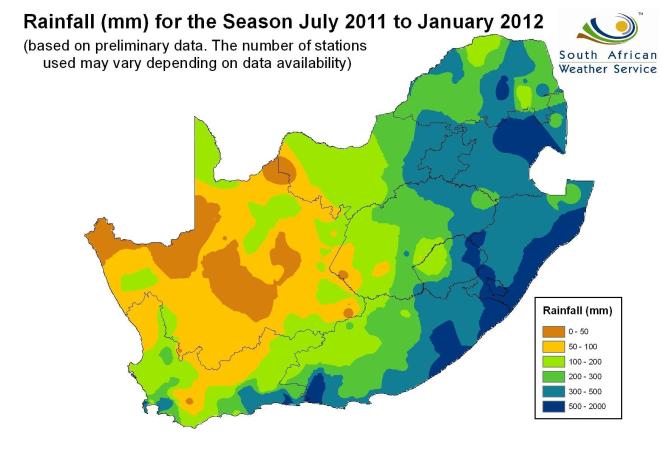Introduction
It is that time of year again! I have 8 seasons worth (i.e., 8 years) of rainfall data for our analytic scrutinization LOL!
The rainfall season for this season and last season has been an immense improvement on our drought years… so lets take a closer look at the numbers, shall we?
The Data
For this season I have decided to up my analytical game and I give you an PowerBI dashboard screenshot with all the data for your perusal!
Annual rainfall ‘average’ for South Africa (which includes the desert areas) pre- El Nino: 470 mm (1901-2016), which is half that of the rest of the world at 985 mm per year! Here is a comparative chart for monthly rainfall (barchart) and temperature (line chart), from the World Bank:


From the charts above comparing the 1901 – 2016 and the 1991 – 2016 it is very noticeable that the average temperature has increased (dramatically so for winter). The rainfall seemed to have shifted towards and increase for Jan-Dec and decrease in Feb-Mar with the rest of the season remaining fairly stable.
My records for rainfall in our area during the main crop production months:
Main Growing Season (Roodepoort, South Africa, 2013-2020, Aug-Jan)
| Rainfall | 2013/14 | 2014/15 | 2015/16 | 2016/17 | 2017/18 | 2018/19 | 2019/20 | 2020/21 |
| Aug | 5.5 | 5 | 10 | 0 | 0 | 0 | 0 | 0 |
| Sep | 3.7 | 9 | 51 | 2 | 0 | 7.5 | 4 | 2 |
| Oct | 109 | 29.5 | 11.5 | 46.5 | 65 | 35 | 4 | 110.5 |
| Nov | 89 | 111.3 | 34.5 | 97 | 143.5 | 41 | 128.5 | 137 |
| Dec | 173.8 | 125.5 | 124.5 | 104 | 102 | 104 | 254 | 98 |
| Jan | 163 | 126.5 | 143.7 | 205 | 77 | 127 | 99 | 111 |
| Total | 544 | 406.8 | 375.2 | 454.5 | 387.5 | 314.5 | 489.5 | 458.5 |
From this table we can clearly see that the rainfall for the Aug – Oct months was alarmingly nearing zero, but we see a good rain for 2020 Oct month. This made a huge difference to the growth season overall, especially considering that December wasn’t such a massive rain dump again. I hope this restoration of the trend holds and that we’ll see good rains this year October again!
I have changed up the graphs here as the previous ones were becoming very cluttered. I created a kind-of dashboard here, wanted to make it in PowerBI but alas the mixture of my daily/monthly records wasn’t going to work here. I provide it down below as a downloadable PDF as it’ll make it easier to interact with the document as PDF instead of an image…
For the 2020 to 2021 trends:
From the yearly and monthly tables the prominent December rainfall trend is evident as well as the reduction of rain during Aug – Oct. We also notice that both Feb and/or March maintain their high rainfall contributions with another rain dump in April. Thus, August and September rainfall are still very low, in 2020 we had received good rain in October, but it still meant a growth season reduction by 2 months! The 2021 rainfall is not all accounted for yet so we will only get the full picture here next year.
From the 2014 to 2021 trends:
Fortunately, this year has meant a major recovery for South Africa’s dams, rivers and underground water reserves. However, our planting season has become impacted and this will determine when we can truly start planting food gardens at large scale – especially considering that many seedlings become established in the Aug – Oct months before the full heat of the summer.
Thus, it remains a priority to capture and store your own water reserves so that you can offset the lack of rain during the Aug – Oct months, water that must be collected and stored over the winter months. Additionally, it means using water sparingly during the winter months and likely forgoing heavy water/nutrient users such as cauliflower and broccoli for the preferential planting of drought resistant and/or smaller crops such as beans, peas, alfalfa, spinach and pak choi in winter.
I would also highly recommend planting fruit trees that are late carriers rather than early. This means that the trees would miss the chilly August winds and frost as well as letting the trees catch the first rains later in the year.
Here are two historical maps of precipitation from the SA Weather Service for more comparisons:


Conclusion
Our region is experiencing a noticeable change in rainfall patterns and we as South Africans truly need to move away from using clean drinking water for pools, garden water features, washing the car or pavement, watering the lawn etc. We all need to start working towards both collecting and saving rainwater for the garden and house as well as reserving clean tap water exclusively for drinking, cooking and personal hygiene. Our household uses 71 liters per person per day and we are do not even feel cheated at all!
How? We have several rain water collection tanks (we have 16000 L worth on the property), please see my post about rain and grey water collection and use. The City of Cape Town government has several great resources on water saving in and around the house/office:
- Top ways to save water
- Water-saving tips/checklist to help avoid Day Zero
- Safe use of Grey Water
- Find and Fix Leaks
- Water Conservation: Smart Office Handbook (only pages 57-65)
- Smart Office Handbook: A Guide to Greening Your Office (full book)